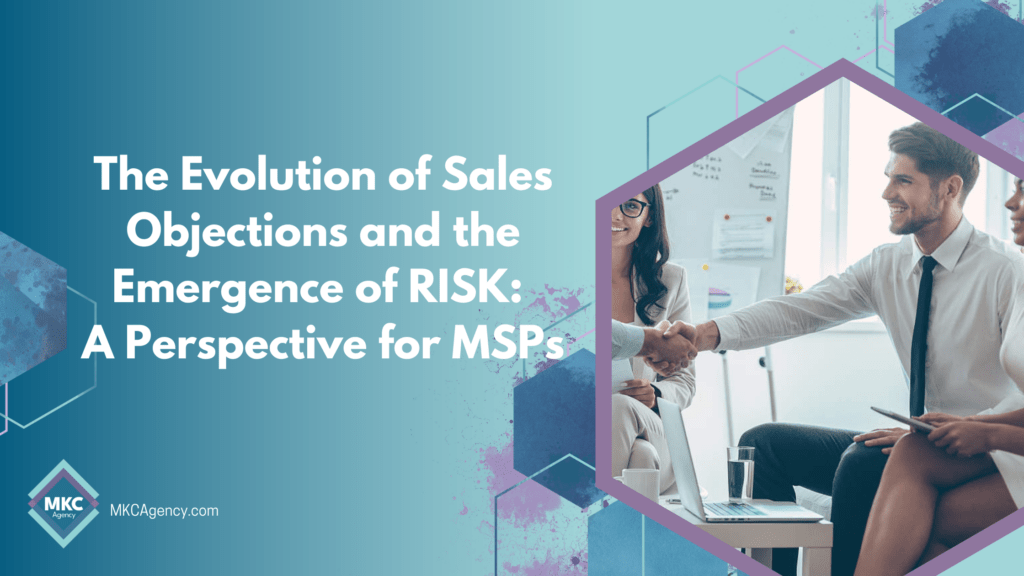When we talk about sales objections, it’s easy to get caught up in the traditional BANT framework. This approach has guided sales pros for decades, focusing on Budget, Authority, Need, and Time. It’s a neat, tidy package that’s served us well, but let’s face it: sales is not a neat, tidy business.
Enter the age of RISK.
That’s right, friends. We’re adding a fifth dimension to the mix that’s particularly important for Managed Service Providers (MSPs): Risk. But before we dive into this, let’s take a step back to look at how we got here.
A Blast from the Past: The BANT Legacy
In the pre-internet age, salespeople had the upper hand in the buying process. They were the gatekeepers of product information, making prospects heavily reliant on them. IBM, one of the tech titans of the time, introduced the BANT methodology in the mid-60s to qualify leads effectively. It was a simpler time with a straightforward sales framework that worked wonders. As GONG explains, it was designed to help sales reps quickly qualify leads by considering a prospect’s Budget, Authority, Need, and Time.
This approach was a revolution, providing a straightforward way to prioritize leads and streamline the sales process. But fast forward to 2023, and the dynamics of sales have changed dramatically. While BANT has its merits, it’s clear we need a more nuanced approach that takes into account the complex, risk-laden landscape MSPs operate in.
The Evolution of Sales Objections
But times have changed. Prospects are more informed than ever before, transforming the sales landscape. This shift demands an evolution in our approach to sales objections, warranting the addition of RISK into our sales acronym repertoire.
Now, you might ask, “Why RISK?” In the realm of Managed Service Providers (MSPs), risk takes on an entirely new dimension. Unlike in traditional sales, the buying decision in the MSP space involves a profound level of trust, since it often means ripping and replacing an existing IT stack. The stakes are high: a wrong choice could lead to massive operational disruption, affecting everything from daily workflows to long-term business strategy.
In this context, risk isn’t just about the financial investment. It’s about potential downtime, data loss, integration hiccups, and a host of other potential issues. The prospect’s perceived risk is significantly amplified, and this is where MSPs can make a difference.
The role of MSP salespeople extends beyond selling services or solutions – they need to reassure prospects that the transition will be smooth, the risk will be managed, and the outcome will be beneficial. They have to build trust and provide evidence that the potential rewards of their service far outweigh any inherent risks.
As such, today’s informed prospects need reassurance that they’re making the right choice, not just based on their Budget, Authority, Needs, and Time, but also considering the potential Risks. The new era of sales demands a deep understanding of these risks and a strategic approach to address them effectively. That’s why we need to shift from the traditional BANT to the more nuanced and comprehensive BANTR.
The Rise of BANTR: Adding Risk to the Equation
While BANT has served us well in the past, the rising prominence of MSPs and other tech-driven businesses has transformed the sales landscape. These types of sales are often more complex, with higher stakes and longer sales cycles, making risk a crucial factor in the buying decision.
Let’s break down BANTR and understand the psychological undertones for each:
- Budget: On the surface, the budget objection might appear to be a straightforward monetary issue, but it often has two prongs.
- One is a matter of perceived value. Behavioral economists like Daniel Kahneman tell us that people are willing to pay more for something they see as valuable. If a prospect objects on the grounds of budget, it could mean they don’t see the value in your offering, signaling a need for better communication of your value proposition.
- The other aspect could be a genuine lack of resources. In this case, the sales process becomes about understanding their constraints and exploring flexible pricing options or demonstrating an exceptional ROI that justifies their investment.
- Authority: When faced with this objection, the person you’re speaking to may not have the power to make or influence the buying decision. This speaks to the fundamental need for people to feel in control, a concept well-documented in psychology. It’s your job to ensure you’re engaging the right decision-makers and empowering your contact to champion your solution within their organization if necessary.
- 3. Need: Every sale addresses a business need or pain point. The psychology of pain avoidance is a powerful motivator—people are generally more motivated to avoid pain than to pursue pleasure. If your prospect doesn’t recognize a need for your solution, they may not have realized the pain they are experiencing without it. Your role is to ask probing questions that uncover this pain and position your offering as the remedy.
- 4. Time: Time-based objections often stem from the human tendency towards short-term thinking and delay discounting—the phenomenon where people opt for smaller rewards now rather than larger rewards later. When a prospect tells you they’re not ready to move forward, they may not have grasped the future benefits and cost savings your solution provides. Illustrating a clear timeline with milestones and benefits at each stage can help counteract this innate bias.
- 5. Risk: This is the newcomer in our BANTR framework, particularly crucial in complex tech sales like MSPs. It’s all about mitigating the fear of the unknown—an inherent trait in humans known as ambiguity aversion. Prospects need to feel confident that the potential rewards of purchasing outweigh any potential risks. As a salesperson, your mission is to alleviate their fears, provide reassurance, and make the unknown known.
Each component of BANTR ties back to fundamental human psychology. Understanding these principles can empower you to diffuse objections effectively, moving away from the dated notion of ‘overcoming’ them. Let’s dive into how to diffuse these objections, so you can foster meaningful, authentic conversations that get to the heart of your prospect’s concerns.
Redefining Sales Objections: The Mindset Shift
Now, let’s discuss the critical paradigm shift in how we address these sales objections. Traditionally, the objective has been to ‘overcome’ objections, but the true secret to success lies in ‘diffusing’ them.
You see, objections aren’t a closing problem; they’re a discovery problem. By carrying out thorough discovery early in the process, we can uncover these potential objections upfront. This preemptive strategy equips us with the knowledge to diffuse any concerns later in the process.
In the end, our job as salespeople (especially ethical salespeople) is to solve our prospects’ problems. So, let’s change our focus from ‘overcoming’ to ‘diffusing’ objections. Instead of pushing to close the deal, let’s take the time to understand, address, and alleviate our prospect’s concerns. This approach paves the way for more productive conversations, stronger relationships, and ultimately, more successful sales.
It’s time to embrace this mindset shift and step into the new era of BANTR. By acknowledging and addressing Risk, we can better cater to our prospects’ needs, mitigate their concerns, and guide them towards a solution that aligns with their specific circumstances.
Diffusing Objections: A Hands-On Approach
Now that we’ve established the shift in mindset, let’s delve deeper into practical steps we can take to diffuse objections, with the emphasis on asking the right questions, listening intently, and understanding the root of these objections.
Budget: When it comes to budget objections, understanding the root cause is crucial. Is it truly a lack of financial resources, or is it a perceived lack of value in what you’re offering? Let’s unpack this.
If your prospect questions the price of your solution, it may not be about the actual dollar amount, but rather their doubt in the value or ROI your solution promises. In this scenario, the key is to articulate the value your product brings, ideally in a language that resonates with them. Use case studies and customer testimonials to paint a clear picture of the tangible return on their investment. The goal is to ensure that your prospect can see the long-term benefits and actual cost-savings your solution offers.
Alternatively, they may genuinely lack the financial resources to purchase your solution. If this is the case, explore flexible pricing or financing options that could meet their budgetary needs. The idea here is to show your willingness to work with them and find an arrangement that’s mutually beneficial. This openness not only shows empathy but also illustrates your commitment to their success, which can go a long way in building trust and relationships.
In either case, demonstrating understanding, flexibility, and a commitment to delivering value are key to diffusing budget objections. By deeply listening to their concerns, you can tailor your approach accordingly and offer a solution that meets their specific needs and circumstances.
Authority: Identifying decision-makers early is key, but so is arming your point of contact with information and tools to advocate for your solution within their organization. The focus is not about sidestepping your contact but empowering them as a key player within their company. Remember to listen attentively to their concerns and offer tailored support, recognizing their influence within the decision-making process.
Need: This is where deep discovery becomes paramount. Uncover the prospect’s pain points by asking open-ended, thought-provoking questions, encouraging them to delve into their challenges and aspirations. Rather than rushing to present your solution, spend time actively listening, allowing their needs to guide the conversation. Only when these needs are articulated and understood can you demonstrate how your solution specifically addresses their pain points.
Time: A clear roadmap of implementation helps your prospect envision the journey ahead, but remember to underscore both immediate and long-term benefits. By actively listening to their time concerns, you can empathize and alleviate any potential anxiety about the process. Present them a clear picture of the future with your solution, helping them see beyond their immediate constraints to the long-term gains.
Risk: Honesty and transparency are critical when discussing potential risks. Remember, trust is built on openness, and part of that is reassuring your prospect that you’re prepared to navigate uncertainties. Discuss potential risks associated with your product or service and explain how you’re equipped to manage them. Use data, case studies, and address their concerns directly to build confidence. It’s not about downplaying risks but managing them honestly and effectively.
Each of these objections represents an opportunity for deeper understanding, dialogue, and connection. It’s not about confrontation or quick fixes; it’s about empathy, active listening, and offering genuine solutions to real challenges. That’s the heart of ethical sales: solving problems and fostering relationships. The shift from overcoming to diffusing objections can revolutionize your sales approach and lead to more rewarding and fruitful sales experiences.
The Future of Sales: A New Era of BANTR
In conclusion, as we step into this new era of BANTR, we must remember that our job as ethical salespeople is to guide our prospects towards the solution that best suits their needs. By being prepared, engaging in thorough discovery, and focusing on diffusing objections rather than overcoming them, we can foster authentic, productive conversations.
At MKC Agency, we’re passionate about ethical marketing and sales practices. If you’re looking to refine your sales strategy and navigate these complex objections more effectively, we’d love to chat.
Schedule a 1:1 consultation today and let’s explore how we can revolutionize your approach to sales and marketing together.
Sources and Further Reading:

